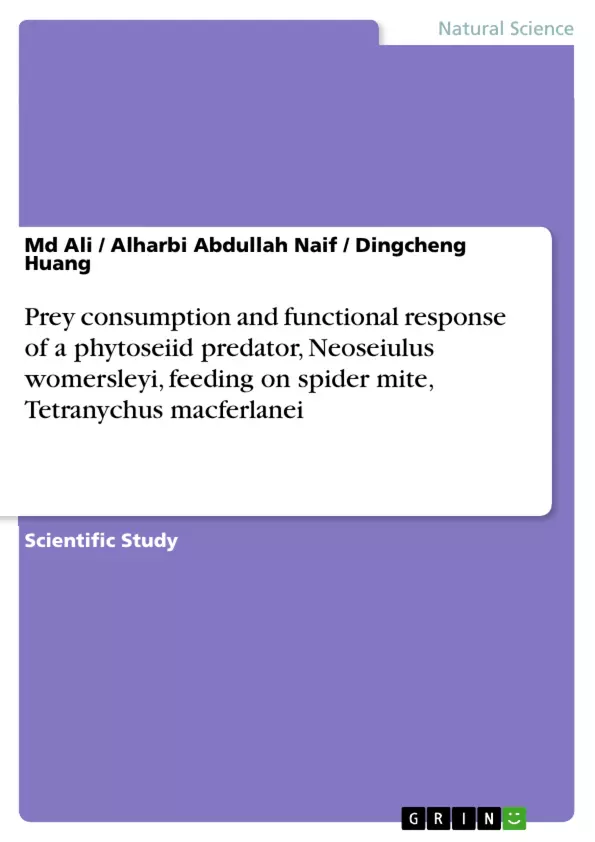The spider mite, Tetranychus macferlani (Baker and Pritchard) (Acari: Tetranychidae) is a pest of various crops and trees with a cosmopolitan geographic range that includes the country of
Bangladesh. This study was conducted to evaluate the biological control potential of the predacious mite, Neoseiulus womersleyi (Schicha) (Acari: Phytoseiidae), against T. macferlani.
The consumption rate (when offered egg, larvae, protonymph, and deutonymph as prey) and functional responses (over different prey densities) of N. womersleyi were investigated in laboratory experiments. Experimental results showed that the predator consumed significantly more larvae than other stages of T. macfarlanei. Logistic regression indicated that the predator exhibited a Type II functional response on all immature stages of prey; the number of prey consumed increased with prey density up to a maximum after which it slowly decreased. The attack rate (a) and handling time (Th) coefficients of a Type II response were estimated by fitting
Holling’s disc equation to the data. The lowest estimated value of a and the highest value of Th were obtained for the predator feeding on deutonymphs. The lowest value of Th was obtained for the predator feeding on larvae. However, the attack rate on larvae was not significantly different than the attack rate obtained on eggs and protonymphs. The predicted maximum daily prey consumption was 212.8 eggs, 238.1 larvae, 53.5 protonymphs, and 29.6 deutonymphs. Thus, our
results suggest that N. womersleyi could be a highly efficient biological control agent of T. macfarlanei at least at low prey densities, although field studies are needed to draw firm
conclusions.
Inhaltsverzeichnis (Table of Contents)
- Introduction
- Materials and Methods
- Stock cultures of mites
- Experimental conditions
- Prey consumption
- Functional response
- Data analysis
- Results
Zielsetzung und Themenschwerpunkte (Objectives and Key Themes)
This study investigates the potential of the predatory mite, Neoseiulus womersleyi, as a biological control agent for the spider mite, Tetranychus macferlanei. The primary objectives are to determine the consumption rates of N. womersleyi when fed different life stages of T. macferlanei and to assess the predator's functional response to various prey densities.
- The impact of different life stages of T. macferlanei on the consumption rate of N. womersleyi
- The functional responses of N. womersleyi to varying densities of different T. macferlanei life stages
- The determination of the attack rate (a) and handling time (Th) coefficients for the predator
- The potential of N. womersleyi for biological control of T. macferlanei populations
Zusammenfassung der Kapitel (Chapter Summaries)
The "Introduction" provides context by highlighting the growing threat posed by phytophagous mites, specifically T. macferlanei, to various crops due to changing environmental conditions. The study's focus on N. womersleyi as a potential biological control agent against T. macferlanei is introduced, highlighting the predator's known efficacy in controlling other spider mites. The "Materials and Methods" section details the methods used to maintain stock cultures of both mites, the experimental conditions, and the procedures for measuring prey consumption and functional responses. The "Results" section presents the findings on consumption rates, functional responses, and attack rate and handling time coefficients, concluding with implications for biological control.
Schlüsselwörter (Keywords)
The main keywords and focus topics of the text are: biological control, prey consumption, functional response, Neoseiulus womersleyi, Tetranychus macferlanei, spider mites, predator-prey interactions, attack rate, handling time, and density dependence. The study investigates the potential of N. womersleyi as a biological control agent against T. macferlanei by examining its prey consumption and functional response characteristics.
- Quote paper
- Md Ali (Author), Alharbi Abdullah Naif (Author), Dingcheng Huang (Author), 2012, Prey consumption and functional response of a phytoseiid predator, Neoseiulus womersleyi, feeding on spider mite, Tetranychus macferlanei, Munich, GRIN Verlag, https://www.hausarbeiten.de/document/198398


